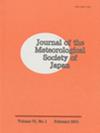基于全球降水测量双频降水雷达的印度次大陆及邻近海域雨滴大小分布的区域差异
IF 1.6
4区 地球科学
Q3 METEOROLOGY & ATMOSPHERIC SCIENCES
引用次数: 12
摘要
利用2014 - 2018年5年全球降水测量双频降水雷达衍生DSD数据,研究了印度次大陆及邻近海域不同气候区域西南季风季节雨滴大小分布(DSD)的变化。降雨率(R)分层DSD测量清楚地表明,陆地、海洋和地形的质量加权平均直径(Dm)值不同。与R无关,大陆雨的Dm值比海洋雨和地形雨的Dm值大。然而,对于浅层风暴,大陆雨的Dm值要小于地形雨和海相雨。根据深层系统的Dm值及其随R值的变化,可以将这些区域划分为4组,其中Dm值基本相等:(1)印度西北部(NWI)和印度半岛东南部(SEPI);(2)喜马拉雅山麓(FHH)和印度中部(CI);(3)印度东北部(NEI)和孟加拉湾(BOB);(4)阿拉伯海(AS)、西高止山脉(WG)和缅甸海岸(MC)。与印度次大陆其他地理区域相比,NWI和SEPI地区深层系统的Dm值最大,WG、MC和AS地区最小;而浅层系统的Dm值在BOB和AS区域最大,在SEPI和NWI区域最小。虽然大陆地区的云滴较小,但雨滴比海洋和地形雨区大。降水过程中发生的微物理和动力过程对大陆雨的DSDs变化起着至关重要的作用。本文章由计算机程序翻译,如有差异,请以英文原文为准。
Regional Differences in Raindrop Size Distribution within Indian Subcontinent and Adjoining Seas as Inferred from Global Precipitation Measurement Dual-frequency Precipitation Radar
Variations in raindrop size distribution (DSD) during the southwest monsoon (SWM) season over different climatic regions in the Indian subcontinent and adjoining seas are studied in this paper using five years (2014 – 2018) of global precipitation measurement dual-frequency precipitation radar derived DSDs. The rain rate (R) stratified DSD measurements show clearly that land, sea, and orography differ in their mass-weighted mean diameter (Dm) values. Irrespective of R, Dm values of deep rain were found to be larger in continental rain than in maritime and orographic rain. However, for shallow storms, the Dm values were smaller for continental rain than for orographic and maritime rain. Based on the Dm values and their variations with R of the deep systems, the regions could be categorized into four groups, within which the Dm values were nearly equal: (1) the northwest India (NWI) and the southeast peninsular India (SEPI); (2) the foothills of the Himalayas (FHH) and the central India (CI); (3) the northeast India (NEI) and the Bay of Bengal (BOB); and (4) the Arabian Sea (AS), the Western Ghats (WG), and the Myanmar coast (MC). Compared to other geographical regions of the Indian subcontinent, the Dm values of the deep systems were the largest over NWI and SEPI and the smallest over the WG, MC, and AS; while for shallow systems, the Dm values were the largest over the BOB and AS and the smallest over the SEPI and NWI regions. Though the cloud drops were smaller over the continental regions, the raindrops were larger than in the maritime and orographic rain regions. The microphysical and dynamical processes that occur during precipitation play a vital role in altering the DSDs of continental rain.
求助全文
通过发布文献求助,成功后即可免费获取论文全文。
去求助
来源期刊
CiteScore
6.70
自引率
16.10%
发文量
56
审稿时长
3 months
期刊介绍:
JMSJ publishes Articles and Notes and Correspondence that report novel scientific discoveries or technical developments that advance understanding in meteorology and related sciences. The journal’s broad scope includes meteorological observations, modeling, data assimilation, analyses, global and regional climate research, satellite remote sensing, chemistry and transport, and dynamic meteorology including geophysical fluid dynamics. In particular, JMSJ welcomes papers related to Asian monsoons, climate and mesoscale models, and numerical weather forecasts. Insightful and well-structured original Review Articles that describe the advances and challenges in meteorology and related sciences are also welcome.

 求助内容:
求助内容: 应助结果提醒方式:
应助结果提醒方式:


